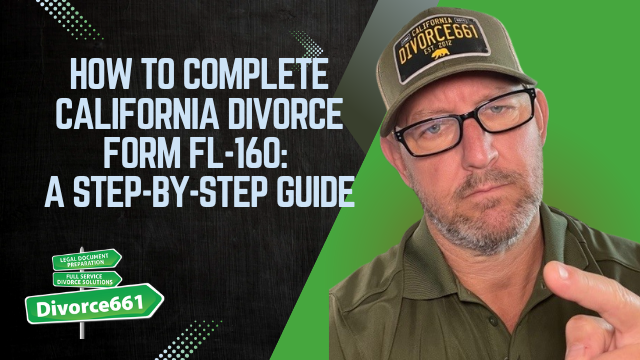How to Complete California Divorce Form FL-160: A Step-by-Step Guide
Filing for divorce in California involves several important legal documents, and one of the most crucial forms you’ll encounter is the Property Declaration Form FL-160. Understanding how to accurately complete this form can make a significant difference, especially if you are navigating a default divorce case. This guide will walk you through everything you need to know about filling out FL-160, based on insights from Tim Blankenship of Divorce661, a licensed and bonded legal document preparation firm specializing in California divorces.
Why the FL-160 Property Declaration Form Matters
The FL-160 form is essential because it details the division of property and debts between spouses. California is a community property state, which means that assets and debts acquired during the marriage are generally divided equally. The courts require this form to ensure an even distribution of property and debts, especially in default cases where one party may not be actively participating.
Tim emphasizes that the form was recently updated as of July 1, 2013, so it’s important to use the latest version to avoid any filing issues. The form is typically used in default divorce cases or during the request to enter default phase, where financial disclosures are necessary.
When to Use FL-160
- Default Divorce Cases: When one spouse does not respond or participate, this form helps the court understand the property division.
- Request to Enter Default: Before filing a true default, you submit property declarations as part of the initial default request.
Keep in mind, two separate FL-160 forms are usually required:
- Community Property Declaration: Covers assets and debts acquired during the marriage.
- Separate Property Declaration: Covers assets and debts owned before the marriage or after separation, which are not subject to division.
Filling Out the Community vs. Separate Property Declaration
Understanding the difference between community and separate property is fundamental:
- Community Property: Anything acquired during the marriage—whether an asset or debt—is generally considered community property and subject to division.
- Separate Property: Assets or debts owned before marriage or obtained after separation that remain solely with one spouse.
When completing each form, you’ll need to provide detailed information about each item:
- Item Description: Clearly state what the asset or debt is (e.g., real estate, furniture, jewelry, vehicles, boats).
- Date Acquired: Month and year are sufficient. This date determines whether the item is community or separate property.
- Fair Market Value: Use a realistic value, such as what you might get at a garage sale, rather than purchase price or online sale value.
- Amount of Debt: List any debt owed on the item.
- Net Fair Market Value: This is the fair market value minus any debt.
Example of Net Fair Market Value Calculation
If you have an asset worth $100 but owe $50 on it, the net fair market value would be $50. This figure is important because it reflects the actual equity in the property.
How to Propose Division of Property
On the community property declaration, property and debts should be divided equally, generally 50/50 between the petitioner and the respondent. For example, if you list an asset valued at $100, you would propose $50 for each party.
However, you can specify if you want to keep a particular item. For instance, if you want to keep a $100 watch, you might allocate the full $100 value to yourself and $0 to the other party. Just be sure that the total community property division balances out to an even split overall.
Tim explains that the court is very particular about this equal distribution and will review the totals at the end of the form to ensure the assets and debts are divided fairly, almost to the penny.
Tips for Completing and Submitting FL-160
- Complete both the community property and separate property declarations, even if you have no property to declare. Simply write “None” in every field to show the court you did not overlook this step.
- Use the most recent version of the form to avoid processing delays.
- Be honest and accurate with values and debts; the court relies heavily on this information to make fair decisions.
- If you’re unsure of how to value an asset, err on the side of a conservative estimate like a garage sale price, as this is generally acceptable.
Final Thoughts
Filling out the California Divorce Form FL-160 may seem daunting, but with a clear understanding of community versus separate property and careful attention to detail, you can complete the form effectively. Remember, the court requires a nearly perfect 50/50 division of community assets and debts, so take your time to ensure everything balances out.
If you need assistance or professional help with your divorce paperwork, consider reaching out to a licensed and bonded legal document preparation firm like Divorce661. Their expertise can help simplify the process and ensure your documents are submitted correctly.
For more detailed guidance and support, you can contact Divorce661 at 661-2867 or visit their website at divorce661.com.

